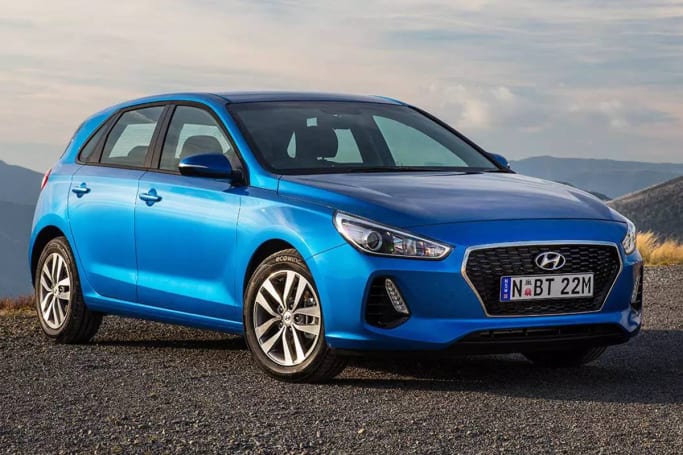
How much does it cost to replace a windscreen?
This used to be a simple question since most car windscreens were made from the...
Browse over 9,000 car reviews

There was a time when Australians visiting Europe were genuinely shocked and disturbed by the size of things. Not just the numbers on their speed-limit signs, nor even their population figures, but the tiny, tiddling nature of their cars.
Europe has long been a place where the VW Golf-sized hatch reigns supreme, and where actual, full-sized humans genuinely consider the Smart car to be an intelligent option.
Perhaps it's a sign that we're becoming more urbane, or at least more urbanite, but Australia has well and truly followed suit, with hatches now replacing Falcodore-sized sedans as the segment of choice.

As any city dweller will tell you, living in Sydney, Melbourne, Brisbane or even relatively grand and spacious Canberra means doing more with less.
Perhaps more tellingly, those of us old enough to remember when service-station signs didn't have space for the $1 before the cents know the pain of fuel economy becoming a very real part of our home economics.
Which is why hatchbacks now make so much sense. Created to do double, triple and quadruple duty, hatches are city workhorses, ready to pile as much as humanly possible into the smallest space available.
They are the easiest way to move about - and stop and park - in cities, and will be until someone invents a reliable method of teleportation. Most modern hatchbacks can take long-range driving in their stride, too, cementing their claims as proper contenders for your garage, if you're lucky enough to still own one.
What's so hot about hatches?
Hatchbacks used to represent the best you could make do with for the smallest amount of money (as long as your pride could take being sneered at by Commodore and Territory owners). They still do, and for almost absurdly small sums, in the case of vehicles like a Suzuki Celerio.
The other side of the freshly minted coin is a new wave of pocket-sized performance that has exploded since the turn of the millennium and shows no signs of slowing.
Ten years ago, the 184kW Alfa Romeo 147 GTA stood as the most powerful hot hatch in existence and it seemed that hot hatches were reaching peak performance.
The bulk of hatchbacks serve as a lightweight, fuel-efficient way to make the most of not much.
Today, cars like the mental Mercedes-Benz A45 deliver huge power – 280kW – can seat five (at least if they're skinny) and embarrass anything this side of a rocket launcher, at a relative bargain price.
The bulk of hatchbacks, however, serve as a lightweight, fuel-efficient way to make the most of not much.
The short overhangs make them a cinch to park and the bluff rear ends mean that rear headroom and luggage space aren't overly compromised by stylistic swoops.
Because the interior of hatches tends to be smaller than sedans, wagons and SUVs, manufacturers go all out to maximise available space. Rear seats fold and tumble forward to maximise luggage space for bulky items, or lift out completely.
Hatches don't have to be small
Thanks to their relatively diminutive proportions, small and medium hatches can deal with the unique situations cities throw at the urban warrior, such as narrow lanes, small parking spots and tight turns. They'll also be cheaper to run and maintain, thanks to smaller and simpler components. Just compare the cost of a set of new tyres for a Suzuki Swift with something like a Toyota RAV4.
Hatches don't have to be small, either. Some large cars, such as the left-field Tesla, as well as a few niche-busting Audis and strangely odd-looking BMWs, use a long, sloping hatchback to improve cargo space. In the case of Teslas and Audis, the aesthetics don't suffer, but if you look at a 3 Series GT with longing, it's time for a new jacket that does up at the back. The 4 Series Gran Coupe on the other hand, is one of the best looking Beemers they make.
What's the downside of downsizing?
There are scant few reasons to bypass hatches, and most of them are either downright picky or old-fashioned. The most compelling argument is obviously one of size, particularly in a world where human beings are getting bigger.
While hatches make the most of their space, they won't ever give you the grandiosity of wagons or SUVs, or people movers.

If you and yours can't squeeze into hatches like the Golf, Focus, 3 and Corolla, there are a few larger ones masquerading as sedans, such as the Skoda Octavia, which warrant some attention.
If that doesn't cut the mustard, it's time to step into a wagon but, because you're a human being that lives in Australia, you'll buy an SUV instead.
Out on the open road, smaller and cheaper hatches can start to display a few shortcomings that slip under the radar in urban environments.
Smaller engines with less power are the most obvious inadequacy, but low-tech solutions such as live rear axles and rear drum brakes are still common towards the bottom end of the market.
Conversely, high-end hatches tend to have sportier characters with firm suspension to match. This can make long-distance cruises a chore, especially over poorer surfaces.

In terms of sheer driving pleasure, there's plenty to be had at the Golf GTI/RenaultSport Megane end of the market, while rear-wheel-drive fun is only available in the BMW 1 Series, which has packaging issues of its own (small cars and transmission tunnels don't mix).
To hatch or not to hatch?
Hatchbacks match the city ethos more than any other, as Europeans have known for years: fitting as much as possible, as comfortably as possible, into as small a space as possible.
The earliest examples of the breed, such as the Renault 4 and Volkswagen Golf, were created to do just that. The original Mini and Fiat 500, while not technically hatches, followed the same principles. Modern versions of both now offer hatchback practicality with style.
Cities aren't getting any less crowded, nor will they, while you've probably noticed that parking spaces seem to be getting smaller, unlike fuel prices, which only trend one way.
Hatches make sense, even if they can be about as exciting as washing machines, but at least modern ones do offer a level of performance, practicality and pampering that belies their humble origins.
Why SUVs are becoming so popular
Why a wagon is worth considering over an SUV
Why people buy coupes even though they're not perfect
Why should I buy a convertible?
Utes are the most versatile car on the road but should I buy one?










Comments